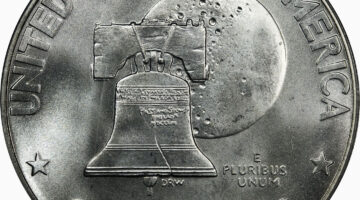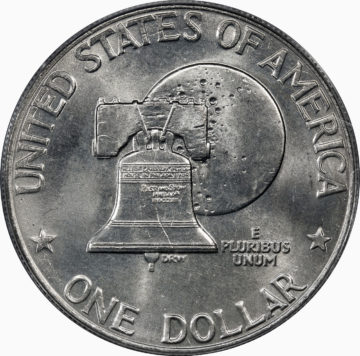Looking for Eisenhower dollar errors and varieties worth a lot of money?
There certainly are plenty out there to look for!
Eisenhower Dollar Coin Facts
Ike dollars were struck from 1971 through 1978 — and the relatively short-lived series serving as America’s last circulating large-size dollar coin saw a lot of cool varieties and errors.
Eisenhower dollars feature an obverse (heads side) portrait of Dwight D. Eisenhower, who was a five-star World War II army general and served as the nation’s 34th president from 1953 through 1961. The reverse (tails side) depicts the mission insignia for Apollo 11, the NASA spacecraft that took the first men to the Moon in 1969.
While Ike dollars were struck for general circulation, the large-size dollar coin measuring 38.1 millimeters wide and weighing at least 22.68 grams was unpopular with many Americans — and it did not commonly appear in pocket change. A large share of these dollar coins were used in Nevada casinos.
Circulating issues were made from copper-nickel clad. The United States Mint also struck limited numbers of 40% silver Eisenhower dollars for collectors and copper-nickel proofs.
The Eisenhower dollar was replaced in 1979 by the Susan B. Anthony dollar — a small-size dollar coin that was also quite unpopular with the public and was discontinued in 1981. A short run was struck in 1999 to fill stockpile shortages caused by the coin’s expanded use in vending machines and in mass transit systems.
7 Eisenhower Dollar Coin Varieties
Most people who build sets of Eisenhower dollars collect just the 32 different major business-strike and proof issues.
But there are many varieties in the series that make this a complex and interesting series to build!
Here are some of the most important varieties…
1971-D Friendly Eagle Dollar Variety
There’s a special variety of 1971-D Eisenhower dollar in which the eagle on the reverse shows a muted eyebrow — giving the bird of prey a decidedly more congenial appearance. This coin also has a more rounded northern shore of the Gulf of Mexico as seen on the planet Earth — just above and to the left of the eagle’s head.
The 1971-D Friendly Eagle dollar, which may number about 500,000 pieces, is a scarce and widely collected variety.
Values range from about $25 for a typical circulated specimen to $40 or much higher for uncirculated examples.
1971-S Peg Leg Dollar Variety
There aren’t any pirates involved with this interesting Eisenhower dollar variety, but some “RRRrrrrrrrrrrrrr” does prominently feature on this rare error coin!
The 1971-S Peg Leg dollar shows a missing serif on the lower left leg of the “R” in “LIBERTY” on the obverse. The absence of fluting gives the left leg of the “R” a blocky look — almost as if it has a pegged leg.
The 1971-S Peg Leg Eisenhower dollar trades for about $75 in uncirculated grade.
3 Types Of 1972 Eisenhower Dollar Varieties
There are three major varieties among 1972 Eisenhower dollars — all primarily involving the appearance of the landforms on the planet Earth on the reverse of the coin. Here are the identifying features and values for each of the three different 1972 Ike dollar varieties:
1972 Type I Dollar – Among the most common of the 1972 dollar varieties is the Type I, which was struck in low relief and shows some errors in the way Florida and the island of Cuba look. The long peninsula of Florida appears as a short stump, while the banana-shaped nation of Cuba looks something like a round blob on the coin.
- In circulated grades, the value is $1.05 to $1.15.
- In uncirculated values range from about $10 to more.
- The record price for this coin is $7,475!
1972 Type II Dollar – The rarest of the three varieties of 1972 Eisenhower dollars, the Type II is typified by a long, triangular representation of the Florida peninsula and the faint Caribbean islands.
- Even circulated examples of this coin (which is estimated to have seen just 100,000 struck!) are worth about $25 or more.
- Uncirculated specimens of this 1972 dollar are worth about $100 and up.
- The record price for this coin stands at a whopping $3,055!
1972 Type III Dollar — This version of the map looks the most realistic and shows Florida and Cuba closer to their geographical shapes and proportions, and all the land forms, including the Caribbean islands, look more pronounced. This is a scarcer variety that is worth significantly more than face value.
- Worn examples of this 1972 Eisenhower dollar are worth about $5 to $10.
- Uncirculated specimens have a value of $20 or more.
2 Types Of 1976 Bicentennial Dollar Varieties
There are two major varieties known to exist among 1776-1976 Bicentennial dollar coins. Here are the differences — and whether or not they’re rare and valuable:
1976 Type I Dollar — This version of the 1976 Bicentennial dollar shows blocky, sans-serif lettering on the reverse and is slightly scarcer than the Type II. All 1976 Bicentennial dollars made from 40% silver are of the Type I.

- Worn examples of the clad 1976 Type I variety are worth about $1.05 to $1.10.
- Uncirculated clad pieces have a value of around $3 or more.
- The 1976 Type I clad proofs are worth approximately $7 and up.
- 1976 Type I 40% silver uncirculated pieces are worth upward of $12.
- 1976 Type I 40% silver proofs have a value of $15 or more.
1976 Type II Dollar — The Type II 1976 dollar has more refined, serifed lettering on the reverse and is more common. None of the 40% silver uncirculated or proof 1976 dollars are of the Type II variety.
- Circulated Type II dollars are worth about $1.05 to $1.10.
- Uncirculated Type II 1976 dollars have a value of $3 or more.
- Type II proof 1976 Ike dollars are worth $3 to $5 and up.
7 Eisenhower Dollar Coin Errors
There are several notable Eisenhower dollar errors — including a handful of rare and valuable errors involving unintentional off-metal silver dollar strikes.
Let’s examine 7 of the most notable Eisenhower dollar coin errors:
1974-D 40% Silver Dollar Error
Millions of 40% silver Eisenhower dollars were meant to be struck as uncirculated and proof examples at the San Francisco Mint.
However, somehow 25 to 30 of these silver planchets were mistakenly struck at the Denver Mint with dies intended for 1974-D clad dollars.
These rare, off-metal 1974-D silver dollar errors have sold for more than $8,000.
1977-D 40% Silver Dollar Error
The 1977-D 40% silver Eisenhower dollar error was made in much the same fashion as the 1974-D silver Eisenhower dollar.
However, these off-metal dollar errors were made in even smaller numbers than its 1974-D dollar predecessor, with just 15 known.
The 1977-D silver dollar error has sold for more than $17,000!
Other Eisenhower Dollar Errors
Here are some of the other types of valuable Eisenhower dollar errors and their current values:
- Clipped planchets — $30+
- Multiple strikes (different than doubled dies) — $1,000+
- Blank planchets — $100+
- Off center strikes — $550+
- Broadstrikes — $125+
Tips For Finding Valuable Eisenhower Dollar Varieties & Errors
While many rare error coins and varieties can be found with careful and persistent searching of bank rolls, boxes, and bags of coins, it’s a little different for Eisenhower dollars.
They haven’t been readily available at banks since the late 1970s and early 1980s. Some financial institutions still receive the occasional Ike dollar. But it’s pretty rare to find these coins sitting in tellers’ tills and bank vaults these days.
So, you’ll have to get creative if you want to try your hand at finding these valuable Eisenhower dollars at prices closer to their face value.
Here are 3 tips you’re sure to find helpful:
- Search estate sales and garage sales. You might find Eisenhower dollars at the next local community sale or a rummage sale. Lots of people have these large dollar coins and sell them. Perhaps if you’re lucky you may find some of these varieties or errors discounted well below book value.
- Ask friends and family. Maybe you have a relative or good friend who has some Eisenhower dollars on hand. They might be willing to give them to you if they know you’re a coin collector. Of course, if you happen upon one of these rare or valuable Eisenhower dollar errors or varieties in a collection given to you by a loved one and sell it, the right thing to do is to offer to split the earnings!
- Cherrypick coin dealer inventories. Many collectors have scored some lucky finds at coin shops. Believe it or not, many coin dealers don’t place much value on modern coins such as the Eisenhower dollar and don’t pay attention to learning about die varieties and errors on these coins. That doesn’t mean you can’t score a lucky find by cherrpyicking an unusual Ike dollar priced and marked as an otherwise ordinary coin. Unlike the case of scoring a rare Eisenhower dollar given to you by a friend or family member, it’s on the dealer if they didn’t properly identify a coin they’re selling. Their unfortunate loss is your legitimate gain!






